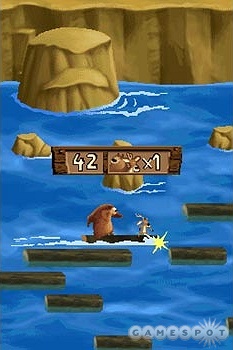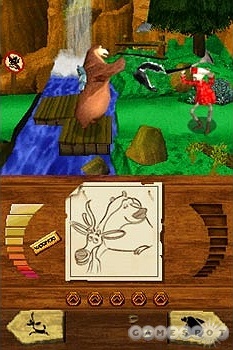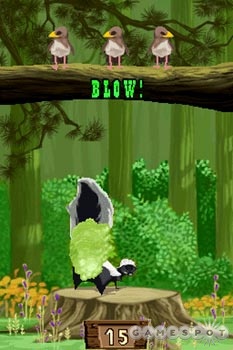Loosely based on the animated film of the same name, Open Season for the Nintendo DS is a side-scrolling adventure game where you have to switch between two different characters to get through a large forest full of puzzles and traps. The game borrows heavily from classics like Klonoa and Lost Vikings in that you have to wander into the foreground and background of the not-quite-2D, not-quite-3D environments while using one character's abilities to deal with obstacles that are standing in the other's way. People looking for an action game will probably be turned off by how the numerous puzzles constantly halt their forward movement, but fans of spatial puzzles and anyone looking for something different in a side-scroller may enjoy the unique makeup of this movie tie-in.

Like the movie, the game concerns the story of Boog, a city-dwelling grizzly bear, who wakes up deep in the woods after a night of partying with his new friend, a deer named Elliot. Since neither of them want to spend the rest of their lives foraging for food, they immediately decide to make their way back to the city. In the movie, the two friends meet a number of animals along the way, get into some wacky situations to earn those animals' trust, and end up involved in a few action-packed sequences. In the DS game, this same trip through the forest is depicted as a series of 27 levels where you have to deal with one puzzling obstacle after another.
On the surface, the game looks and sounds like a typical side-scroller. You alternate control between Boog and Elliot and maneuver the pair from one end of each level to the other. Along the way, you'll encounter angry animals and hunters, as well as a wide variety of puzzles that generally involve pushing switches or setting a heavy object down someplace. There aren't any weapons in the traditional sense, but you can pick up and toss friendly animals at unfriendly animals and hunters to stun them. By the end of the game, you'll be throwing rabbits and porcupines like they were rocks, skunks like they were stink bombs, and ducks like they were heat-seeking missiles.
That's where the similarities to the typical side-scroller end. First off, while the levels primarily involve travel from left to right, the environments allow a 2.5D range of movement, such that you can move up and down to dodge enemies. There are also many spots where you can follow paths into the foreground or background, much like in Namco's Klonoa series, which lead to segments that run parallel to the main path. Another feature distinguishing Open Season from the other Mario clones out there is the number of puzzles contained within each level. There are dozens of them per level. Most involve simple tasks, like getting past a pattern of falling trees or carrying an object from one spot to another to use it as a makeshift stair. Some are trickier, though, and involve figuring out how to deal with sequences incorporating multiple objects, enemies, and hazards. The game may be too tricky for young children, but there's nothing here that anyone over the age of 8 can't handle.

Besides borrowing from Klonoa, the game takes inspiration from Blizzard's Lost Vikings in that you have to swap between the two characters constantly. One of the game's more common puzzle scenarios involves positioning one character on an elevator platform and then locating and pushing the switch to activate it with the other character. Inevitably, the character that receives the boost then has to find the switch up top that will let the other character take the same elevator. Those who have seen the movie will appreciate how Ian, the alpha male of Elliot's herd, has been incorporated into the game. When you encounter him, he's like a mighty wall that can't be moved. However, if you have Boog pick up Elliot and throw him over Ian, and then have Elliot dash into Ian's rear end, Ian will take off running. What further necessitates this kind of teamwork is that Boog and Elliot each have unique abilities. Boog can carry heavy objects, throw stunned enemies, and toss Elliot into switches. Elliot, meanwhile, can jump, perform a goofy dance to distract enemies, and run into things with his head.
The controls incorporate the system's microphone and touch screen, but they're still very straightforward. Using the directional pad and main buttons, you can move the characters around, have them tiptoe, or have them pick up and throw smaller animals. Boog's roar is performed by holding the L button and blowing or shouting into the microphone. Elliot's dash attack is initiated by holding the L button and tapping the touch screen a few times to turn him loose. Tapping the indicated spots on the touch screen lets you easily switch between controlling Boog independently, Elliot independently, or Boog with Elliot following behind.
Despite the emphasis on puzzles, the graphics and audio aren't nearly as austere as what we've seen in games of this type. In fact, the production values are more in line with some of the better Nintendo DS action games. The levels are put together with 3D graphics that look great, particularly the waterfalls and rivers, and the camera perspective changes often to make it seem like there's an entire world all around Boog and Elliot. Being able to follow paths into the foreground or background helps further this impression, as does the way enemies fly into the foreground when Boog tosses them. The only real knock against the environments is that they're all forest themed, and many of the same objects are recycled frequently. Like the environments, the characters are put together with textured polygons. The character models are rather coarse in appearance compared to the geography around them, but they all move fluidly and with a bit of comic swagger. Cute details, such as Boog's teddy-bear backpack and Elliot's missing antler, are also evident. As for the audio, it's solid even if it isn't remarkable. The background music is suitably peppy and has a country twang, the sound effects are diverse and whimsical, and there are a few voice snippets here and there.

The story mode spans 27 levels, each requiring about 10 minutes or so to finish. It should take you around four or five hours to finish, which is fairly typical for handheld games these days. In addition to the main story mode, there are eight different minigames. Seven of them are solo tasks, such as pulling porcupine quills out of Boog's butt or dropping propane tanks onto hunters. The other minigame is a competitive multiplayer game where two players have to play keep-away with Boog's backpack and simultaneously collect as many crackers as possible before time runs out. It's not all that compelling, but the five different environments offer enough tricks and traps to warrant at least a few minutes to check it out. To do so, you'll need to find a friend with a copy of the game, or have the ability to connect to Nintendo's Wi-Fi connection service. Why the developers bothered to implement online play for a single minigame is a mystery, but the option is nevertheless available and works as advertised. The solo minigames are put together with simplistic 2D graphics and employ the touch screen almost exclusively, while the multiplayer game uses the same 3D engine and controls that the story mode does.
Open Season for the Nintendo DS is by no means groundbreaking, but it does mix together a variety of video game standards in a way that's both pleasant and refreshing. The 2.5D graphics and tag-team design help set this side-scroller apart from other movie tie-ins.